[English] 日本語
 Yorodumi
Yorodumi- PDB-3fxi: Crystal structure of the human TLR4-human MD-2-E.coli LPS Ra complex -
+ Open data
Open data
- Basic information
Basic information
| Entry | Database: PDB / ID: 3fxi | |||||||||
|---|---|---|---|---|---|---|---|---|---|---|
| Title | Crystal structure of the human TLR4-human MD-2-E.coli LPS Ra complex | |||||||||
 Components Components |
| |||||||||
 Keywords Keywords | IMMUNE SYSTEM / Leucine Rich Repeat / Glycoprotein / Immune response / Inflammatory response / Innate immunity / Membrane / Receptor / Transmembrane / Secreted | |||||||||
| Function / homology |  Function and homology information Function and homology informationdetection of fungus / nitric oxide production involved in inflammatory response / MHC class II biosynthetic process / positive regulation of cellular response to macrophage colony-stimulating factor stimulus / lipopolysaccharide immune receptor activity / positive regulation of nucleotide-binding oligomerization domain containing 1 signaling pathway / positive regulation of matrix metallopeptidase secretion / Toll-like receptor 4 binding / detection of lipopolysaccharide / regulation of dendritic cell cytokine production ...detection of fungus / nitric oxide production involved in inflammatory response / MHC class II biosynthetic process / positive regulation of cellular response to macrophage colony-stimulating factor stimulus / lipopolysaccharide immune receptor activity / positive regulation of nucleotide-binding oligomerization domain containing 1 signaling pathway / positive regulation of matrix metallopeptidase secretion / Toll-like receptor 4 binding / detection of lipopolysaccharide / regulation of dendritic cell cytokine production / lipopolysaccharide receptor complex / MyD88-independent TLR4 cascade / negative regulation of interleukin-23 production / cellular response to oxidised low-density lipoprotein particle stimulus / TRIF-mediated programmed cell death / wound healing involved in inflammatory response / B cell proliferation involved in immune response / nucleotide-binding oligomerization domain containing 1 signaling pathway / positive regulation of nucleotide-binding oligomerization domain containing 2 signaling pathway / positive regulation of stress-activated MAPK cascade / Toll Like Receptor 4 (TLR4) Cascade / intestinal epithelial structure maintenance / Caspase activation via Death Receptors in the presence of ligand / positive regulation of interleukin-1 production / macrophage activation / Regulation of TLR by endogenous ligand / astrocyte development / TRIF-dependent toll-like receptor signaling pathway / microglia differentiation / nucleotide-binding oligomerization domain containing 2 signaling pathway / NAD+ nucleosidase activity, cyclic ADP-ribose generating / positive regulation of MHC class II biosynthetic process / positive regulation of macrophage activation / positive regulation of platelet activation / positive regulation of lipopolysaccharide-mediated signaling pathway / negative regulation of interleukin-17 production / MyD88 deficiency (TLR2/4) / positive regulation of cytokine production involved in inflammatory response / positive regulation of chemokine (C-X-C motif) ligand 2 production / positive regulation of extrinsic apoptotic signaling pathway / IRAK4 deficiency (TLR2/4) / negative regulation of cold-induced thermogenesis / positive regulation of macrophage cytokine production / positive regulation of smooth muscle cell migration / MyD88-dependent toll-like receptor signaling pathway / MyD88:MAL(TIRAP) cascade initiated on plasma membrane / T-helper 1 type immune response / toll-like receptor 4 signaling pathway / toll-like receptor signaling pathway / RSV-host interactions / positive regulation of NLRP3 inflammasome complex assembly / negative regulation of osteoclast differentiation / positive regulation of reactive oxygen species biosynthetic process / cellular response to lipoteichoic acid / negative regulation of interleukin-6 production / negative regulation of type II interferon production / Respiratory syncytial virus (RSV) attachment and entry / positive regulation of interferon-alpha production / positive regulation of interleukin-10 production / negative regulation of tumor necrosis factor production / phagocytosis / cellular defense response / phagocytic cup / stress-activated MAPK cascade / coreceptor activity / positive regulation of chemokine production / JNK cascade / cellular response to platelet-derived growth factor stimulus / ruffle / positive regulation of B cell proliferation / ERK1 and ERK2 cascade / nitric oxide biosynthetic process / positive regulation of interleukin-12 production / Regulation of TBK1, IKKε (IKBKE)-mediated activation of IRF3, IRF7 / IRAK2 mediated activation of TAK1 complex upon TLR7/8 or 9 stimulation / positive regulation of smooth muscle cell proliferation / TRAF6-mediated induction of TAK1 complex within TLR4 complex / positive regulation of interferon-beta production / lipopolysaccharide-mediated signaling pathway / Activation of IRF3, IRF7 mediated by TBK1, IKKε (IKBKE) / IKK complex recruitment mediated by RIP1 / positive regulation of interleukin-1 beta production / positive regulation of interleukin-8 production / positive regulation of JNK cascade / lipopolysaccharide binding / Heme signaling / cellular response to mechanical stimulus / positive regulation of NF-kappaB transcription factor activity / negative regulation of ERK1 and ERK2 cascade / cellular response to type II interferon / positive regulation of interleukin-6 production / positive regulation of type II interferon production / cellular response to amyloid-beta / positive regulation of inflammatory response / positive regulation of nitric oxide biosynthetic process / positive regulation of tumor necrosis factor production / transmembrane signaling receptor activity / signaling receptor activity / amyloid-beta binding / ER-Phagosome pathway Similarity search - Function | |||||||||
| Biological species |  Homo sapiens (human) Homo sapiens (human) | |||||||||
| Method |  X-RAY DIFFRACTION / X-RAY DIFFRACTION /  SYNCHROTRON / SYNCHROTRON /  MOLECULAR REPLACEMENT / Resolution: 3.1 Å MOLECULAR REPLACEMENT / Resolution: 3.1 Å | |||||||||
 Authors Authors | Park, B.S. / Song, D.H. / Kim, H.M. / Lee, J.-O. | |||||||||
 Citation Citation |  Journal: Nature / Year: 2009 Journal: Nature / Year: 2009Title: The structural basis of lipopolysaccharide recognition by the TLR4-MD-2 complex Authors: Park, B.S. / Song, D.H. / Kim, H.M. / Choi, B.-S. / Lee, H. / Lee, J.-O. | |||||||||
| History |
|
- Structure visualization
Structure visualization
| Structure viewer | Molecule:  Molmil Molmil Jmol/JSmol Jmol/JSmol |
|---|
- Downloads & links
Downloads & links
- Download
Download
| PDBx/mmCIF format |  3fxi.cif.gz 3fxi.cif.gz | 323.6 KB | Display |  PDBx/mmCIF format PDBx/mmCIF format |
|---|---|---|---|---|
| PDB format |  pdb3fxi.ent.gz pdb3fxi.ent.gz | 257.3 KB | Display |  PDB format PDB format |
| PDBx/mmJSON format |  3fxi.json.gz 3fxi.json.gz | Tree view |  PDBx/mmJSON format PDBx/mmJSON format | |
| Others |  Other downloads Other downloads |
-Validation report
| Summary document |  3fxi_validation.pdf.gz 3fxi_validation.pdf.gz | 2.3 MB | Display |  wwPDB validaton report wwPDB validaton report |
|---|---|---|---|---|
| Full document |  3fxi_full_validation.pdf.gz 3fxi_full_validation.pdf.gz | 2.4 MB | Display | |
| Data in XML |  3fxi_validation.xml.gz 3fxi_validation.xml.gz | 60.5 KB | Display | |
| Data in CIF |  3fxi_validation.cif.gz 3fxi_validation.cif.gz | 79.8 KB | Display | |
| Arichive directory |  https://data.pdbj.org/pub/pdb/validation_reports/fx/3fxi https://data.pdbj.org/pub/pdb/validation_reports/fx/3fxi ftp://data.pdbj.org/pub/pdb/validation_reports/fx/3fxi ftp://data.pdbj.org/pub/pdb/validation_reports/fx/3fxi | HTTPS FTP |
-Related structure data
- Links
Links
- Assembly
Assembly
| Deposited unit | 
| ||||||||
|---|---|---|---|---|---|---|---|---|---|
| 1 |
| ||||||||
| Unit cell |
|
- Components
Components
-Protein , 2 types, 4 molecules ABCD
| #1: Protein | Mass: 68838.328 Da / Num. of mol.: 2 / Fragment: extracellular domain, residues 27-631 Source method: isolated from a genetically manipulated source Source: (gene. exp.)  Homo sapiens (human) / Gene: TLR4 / Plasmid: pAcGP67A / Cell (production host): HIGH FIVE CELLS / Production host: Homo sapiens (human) / Gene: TLR4 / Plasmid: pAcGP67A / Cell (production host): HIGH FIVE CELLS / Production host:  Trichoplusia ni (cabbage looper) / References: UniProt: O00206 Trichoplusia ni (cabbage looper) / References: UniProt: O00206#2: Protein | Mass: 16385.941 Da / Num. of mol.: 2 Source method: isolated from a genetically manipulated source Source: (gene. exp.)  Homo sapiens (human) / Gene: ESOP1, LY96, MD-2, MD2 / Plasmid: pAcGP67A / Cell (production host): HIGH FIVE CELLS / Production host: Homo sapiens (human) / Gene: ESOP1, LY96, MD-2, MD2 / Plasmid: pAcGP67A / Cell (production host): HIGH FIVE CELLS / Production host:  Trichoplusia ni (cabbage looper) / References: UniProt: Q9Y6Y9 Trichoplusia ni (cabbage looper) / References: UniProt: Q9Y6Y9 |
|---|
-Sugars , 4 types, 14 molecules 
| #3: Polysaccharide | L-glycero-alpha-D-manno-heptopyranose-(1-7)-L-glycero-alpha-D-manno-heptopyranose-(1-3)-L-glycero- ...L-glycero-alpha-D-manno-heptopyranose-(1-7)-L-glycero-alpha-D-manno-heptopyranose-(1-3)-L-glycero-alpha-D-manno-heptopyranose-(1-5)-[3-deoxy-alpha-D-manno-oct-2-ulopyranosonic acid-(2-4)]3-deoxy-alpha-D-manno-oct-2-ulopyranosonic acid-(2-6)-2-amino-2-deoxy-alpha-D-glucopyranose-(1-6)-2-amino-2-deoxy-alpha-D-glucopyranose Source method: isolated from a genetically manipulated source | ||||
|---|---|---|---|---|---|
| #4: Polysaccharide | 2-acetamido-2-deoxy-beta-D-glucopyranose-(1-4)-2-acetamido-2-deoxy-beta-D-glucopyranose Source method: isolated from a genetically manipulated source #5: Polysaccharide | L-glycero-alpha-D-manno-heptopyranose-(1-7)-L-glycero-alpha-D-manno-heptopyranose-(1-3)-L-glycero- ...L-glycero-alpha-D-manno-heptopyranose-(1-7)-L-glycero-alpha-D-manno-heptopyranose-(1-3)-L-glycero-alpha-D-manno-heptopyranose-(1-5)-[3-deoxy-alpha-D-manno-oct-2-ulopyranosonic acid-(2-4)]3-deoxy-alpha-D-manno-oct-2-ulopyranosonic acid-(2-6)-2-amino-2-deoxy-beta-D-glucopyranose-(1-6)-2-amino-2-deoxy-alpha-D-glucopyranose | Source method: isolated from a genetically manipulated source #10: Sugar | ChemComp-NAG / |
-Non-polymers , 6 types, 24 molecules 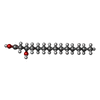
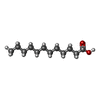
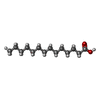








| #6: Chemical | ChemComp-FTT / #7: Chemical | #8: Chemical | #9: Chemical | ChemComp-PO4 / #11: Chemical | #12: Water | ChemComp-HOH / | |
|---|
-Details
| Has protein modification | Y |
|---|---|
| Nonpolymer details | RESIDUES FROM 1001 TO 1018 IN THE CHAINS A AND B ARE E.COLI LIPOPOLYSA |
-Experimental details
-Experiment
| Experiment | Method:  X-RAY DIFFRACTION / Number of used crystals: 1 X-RAY DIFFRACTION / Number of used crystals: 1 |
|---|
- Sample preparation
Sample preparation
| Crystal | Density Matthews: 3.51 Å3/Da / Density % sol: 64.91 % |
|---|---|
| Crystal grow | Temperature: 278 K / Method: vapor diffusion, hanging drop / pH: 7.5 Details: 50mM MgCl2, 0.1M Na-HEPES pH 7.5, 30% PEG MME 550, VAPOR DIFFUSION, HANGING DROP, temperature 278K |
-Data collection
| Diffraction | Mean temperature: 100 K |
|---|---|
| Diffraction source | Source:  SYNCHROTRON / Site: SYNCHROTRON / Site:  ESRF ESRF  / Beamline: ID23-2 / Wavelength: 0.8726 Å / Beamline: ID23-2 / Wavelength: 0.8726 Å |
| Detector | Type: MARRESEARCH / Detector: CCD / Date: Sep 24, 2008 |
| Radiation | Monochromator: SAGITALLY FOCUSED Si(111) / Protocol: SINGLE WAVELENGTH / Monochromatic (M) / Laue (L): M / Scattering type: x-ray |
| Radiation wavelength | Wavelength: 0.8726 Å / Relative weight: 1 |
| Reflection | Resolution: 3.1→47.87 Å / Num. all: 44174 / Num. obs: 41586 / % possible obs: 94.1 % / Observed criterion σ(F): 0 / Observed criterion σ(I): 0 / Redundancy: 4.9 % / Biso Wilson estimate: 91.7 Å2 / Rmerge(I) obs: 0.101 / Rsym value: 0.101 / Net I/σ(I): 13.59 |
| Reflection shell | Resolution: 3.1→3.4 Å / Redundancy: 5 % / Rmerge(I) obs: 0.481 / Mean I/σ(I) obs: 3.88 / % possible all: 86.5 |
- Processing
Processing
| Software |
| ||||||||||||||||||||||||||||
|---|---|---|---|---|---|---|---|---|---|---|---|---|---|---|---|---|---|---|---|---|---|---|---|---|---|---|---|---|---|
| Refinement | Method to determine structure:  MOLECULAR REPLACEMENT MOLECULAR REPLACEMENTStarting model: PDB ENTRY 2Z65, 2Z66 Resolution: 3.1→47.87 Å / Rfactor Rfree error: 0.006 / Occupancy max: 1 / Occupancy min: 1 / Data cutoff high absF: 2098397.3 / Data cutoff low absF: 0 / Isotropic thermal model: anisotropic / Cross valid method: THROUGHOUT / σ(F): 0 / σ(I): 0 / Stereochemistry target values: Engh & Huber
| ||||||||||||||||||||||||||||
| Displacement parameters | Biso max: 174.67 Å2 / Biso mean: 82.2 Å2 / Biso min: 35.78 Å2
| ||||||||||||||||||||||||||||
| Refine analyze |
| ||||||||||||||||||||||||||||
| Refinement step | Cycle: LAST / Resolution: 3.1→47.87 Å
| ||||||||||||||||||||||||||||
| Refine LS restraints |
| ||||||||||||||||||||||||||||
| LS refinement shell | Resolution: 3.1→3.29 Å / Rfactor Rfree error: 0.023 / Total num. of bins used: 6
|
 Movie
Movie Controller
Controller




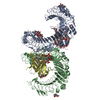
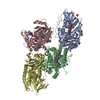
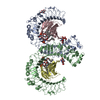
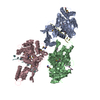
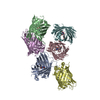
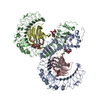

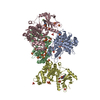
 PDBj
PDBj



















